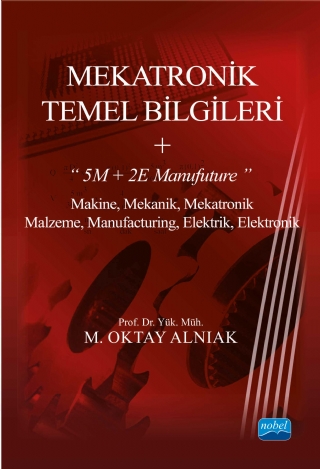Mechatronic Engineering \ 1-1

This book consists of 12 separate chapters. First, the basic characteristics of digital measurement techniques are explained and different examples are given on this subject. Principles of measuring frequency and time interval, principles and architectures of digital-analog and analog-digital converters, internal structures of digital voltmeters and multimeters, methods of measuring non-electrical signals such as displacement with a high accuracy and resolution, principles and algorithms for automatic correction of errors in measuring systems and many sample circuits are given under the title of "Modern Measurement Techniques".
To follow the topics in the book; It is necessary to have knowledge about electrical circuits, electrical and electronic measurements, analog and digital electronics.
Thanks to the topics in the book and the examples given, this book; It has been prepared for the benefit of undergraduate and graduate students and engineers studying in electrical, electronics, computer, mechatronics and control engineering.
To follow the topics in the book; It is necessary to have knowledge about electrical circuits, electrical and electronic measurements, analog and digital electronics.
Thanks to the topics in the book and the examples given, this book; It has been prepared for the benefit of undergraduate and graduate students and engineers studying in electrical, electronics, computer, mechatronics and control engineering.

This book has been prepared in the light of the latest innovations and methods in the ever-changing and evolving field of electronics. With the basic information in the book, it is possible to make all kinds of applications of electronics. The information is enriched with numerical examples and experiments. In this direction, the book will benefit the fields of electrical, electronics, computer, mechatronics and control engineering and department students.

This book has been prepared as a textbook for the Mechanism Technique and Machine Dynamics or a combination of them, Machine Theory courses given in mechanical engineering education.
As a reference source in the field of Machine Theory, which is one of the basic formation fields of mechanical engineering, with its self-sufficient content and tidy structure ranging from mechanism systematics, kinematics and design to the general and major special problems of machine dynamics and the basic mechanical principles that form the basis for them, it is in the library of all mechanical engineers. It is also convenient to be located.
In the book, all the problems in the field of Machine Theory are handled with the analytical/numerical methods required by modern computer aided engineering, and the subjects are tried to be made easy to understand with 127 figures, 17 tables and 64 solution problems chosen for the purpose.
As a reference source in the field of Machine Theory, which is one of the basic formation fields of mechanical engineering, with its self-sufficient content and tidy structure ranging from mechanism systematics, kinematics and design to the general and major special problems of machine dynamics and the basic mechanical principles that form the basis for them, it is in the library of all mechanical engineers. It is also convenient to be located.
In the book, all the problems in the field of Machine Theory are handled with the analytical/numerical methods required by modern computer aided engineering, and the subjects are tried to be made easy to understand with 127 figures, 17 tables and 64 solution problems chosen for the purpose.

This book was basically prepared as a textbook for the Mechanical Vibrations course, which is given in undergraduate engineering education.
However, its framework is not limited to the possible scope of such a course, but is drawn to include relatively advanced topics of vibration science that should be included under the Discrete Linear Systems heading. Thus, it is aimed that the book will appeal not only to students, but also to engineers and scientists.
The subjects of Continuous and Nonlinear Systems left out of this book are left to a second book to complement this book.
The book was tried to be made easy to understand with 113 figures, 13 tables and 90 solved problems selected for the purpose, and the reader was given the opportunity to test himself with 27 unsolved problems with certain answers.
However, its framework is not limited to the possible scope of such a course, but is drawn to include relatively advanced topics of vibration science that should be included under the Discrete Linear Systems heading. Thus, it is aimed that the book will appeal not only to students, but also to engineers and scientists.
The subjects of Continuous and Nonlinear Systems left out of this book are left to a second book to complement this book.
The book was tried to be made easy to understand with 113 figures, 13 tables and 90 solved problems selected for the purpose, and the reader was given the opportunity to test himself with 27 unsolved problems with certain answers.

In this book; technical information is given on machinery, mechanics, mechatronics, materials, manufacturing, electricity and electronics. It can be considered as a technical manual. The problems have been prepared in an original way. Using and converting units is very helpful. Technology cannot correct calculation errors as much as the human mind! While doing a job, hit the brake and stop where you can't understand. Use your mind, ask someone who knows, read this book… Technical works do not make mistakes! Technical personnel who can read and solve problems are very valuable. This is a practice book. It will be very useful for you in technical matters.